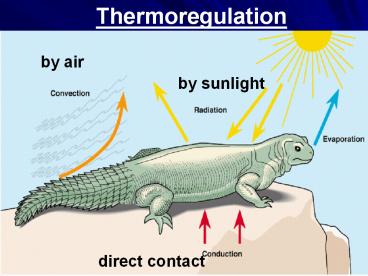Thermoregulation - PowerPoint PPT Presentation
Title:
Thermoregulation
Description:
Ecto/Endotherms Differences are based on source of body heat Which has a higher metabolic rate at cold ... marine vertebrates and some marine inverts Water balance ... – PowerPoint PPT presentation
Number of Views:512
Avg rating:3.0/5.0
Title: Thermoregulation
1
Thermoregulation
by air
by sunlight
direct contact
2
Ecto/Endotherms
- Differences are based on source of body heat
- Which has a higher metabolic rate at cold
temperatures, ectotherms or endotherms? - Endotherms
3
(No Transcript)
4
Mechanisms of Thermoregulation
- Insulation
- Circulatory adaptations (vasodilatation when very
hot and vasoconstriction when cold) - Arteries and veins run countercurrent
- Evaporative heat loss
- Behavioral responses
- Endotherms can regulate metabolic heat production
5
Skin Provides Protection and Thermoregulation
6
(No Transcript)
7
Transport Epithelia
- What is the importance of transport epithelia to
the process of osmoregulation? - Form selectively permeable barrier
- Regulate solute movements
- e.g. salt excreting glands in birds
- Why are most transport epithelia arranged in
tubular networks? - Increase surface area
8
Salt-Excreting Glands in Marine Birds
9
Osmoregulation- How animals regulate
solute concentrations and balance the gain and
loss of water
10
- Osmoconformers are isotonic with environment Ex
most marine inverts - Osmoregulators adjust internal osmolarity Ex
marine vertebrates and some marine inverts - Water balance on land involves adaptations to
conserve water.
11
(No Transcript)
12
Flatworm (Planaria)
13
Earthworm Metanephridia
Metanephridium
14
Malpighian Tubules of Insects
15
Variation in Nitrogenous Wastes
16
Excretory Organs
17
Kidney Cross Section
18
Nephron Structure
19
Nephron Structure
20
Reabsorption
Filtration
Secretion
Secretion
21
Proximal Convoluted Tubule high pressure
filters H2O, urea, vitamins, salts, and glucose
into Bowmans Capsule from the glomerulus where
most reabsorption occurs into peritubular
capillaries secretion of H and NH3 occurs
22
Loop of Henle - creates high concentration of
NaCl promoting the reabsorption of H2O
countercurrent flow leads to a more concentrated
urine
Distal Convoluted Tubule regulates K and NaCl
concentration toxic wastes reabsorbed into the
filtrate forming urine
23
Osmolarity increases as solutes become more
concentrated in millosmoles (moles of solute/L
of solution)
24
(No Transcript)
25
(No Transcript)































